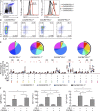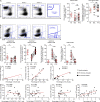Follicular helper T cells serve as the major CD4 T cell compartment for HIV-1 infection, replication, and production
- PMID: 23254284
- PMCID: PMC3549706
- DOI: 10.1084/jem.20121932
Follicular helper T cells serve as the major CD4 T cell compartment for HIV-1 infection, replication, and production
Abstract
In the present study, we have investigated the distribution of HIV-specific and HIV-infected CD4 T cells within different populations of memory CD4 T cells isolated from lymph nodes of viremic HIV-infected subjects. Four memory CD4 T cell populations were identified on the basis of the expression of CXCR5, PD-1, and Bcl-6: CXCR5(-)PD-1(-)Bcl-6(-), CXCR5(+)PD-1(-)Bcl-6(-), CXCR5(-)PD-1(+)Bcl-6(-), and CXCR5(+)PD-1(+)Bcl-6(+). On the basis of Bcl-6 expression and functional properties (IL-21 production and B cell help), the CXCR5(+)PD-1(+)Bcl-6(+) cell population was considered to correspond to the T follicular helper (Tfh) cell population. We show that Tfh and CXCR5(-)PD-1(+) cell populations are enriched in HIV-specific CD4 T cells, and these populations are significantly increased in viremic HIV-infected subjects as compared with healthy subjects. The Tfh cell population contained the highest percentage of CD4 T cells harboring HIV DNA and was the most efficient in supporting productive infection in vitro. Replication competent HIV was also readily isolated from Tfh cells in subjects with nonprogressive infection and low viremia (<1,000 HIV RNA copies). However, only the percentage of Tfh cells correlated with the levels of plasma viremia. These results demonstrate that Tfh cells serve as the major CD4 T cell compartment for HIV infection, replication, and production.
Figures






References
-
- Avery D.T., Deenick E.K., Ma C.S., Suryani S., Simpson N., Chew G.Y., Chan T.D., Palendira U., Bustamante J., Boisson-Dupuis S., et al. 2010. B cell–intrinsic signaling through IL-21 receptor and STAT3 is required for establishing long-lived antibody responses in humans. J. Exp. Med. 207:155–171 10.1084/jem.20091706 - DOI - PMC - PubMed
-
- Betts M.R., Ambrozak D.R., Douek D.C., Bonhoeffer S., Brenchley J.M., Casazza J.P., Koup R.A., Picker L.J. 2001. Analysis of total human immunodeficiency virus (HIV)-specific CD4(+) and CD8(+) T-cell responses: relationship to viral load in untreated HIV infection. J. Virol. 75:11983–11991 10.1128/JVI.75.24.11983-11991.2001 - DOI - PMC - PubMed
Publication types
MeSH terms
Substances
LinkOut - more resources
Full Text Sources
Other Literature Sources
Medical
Research Materials

